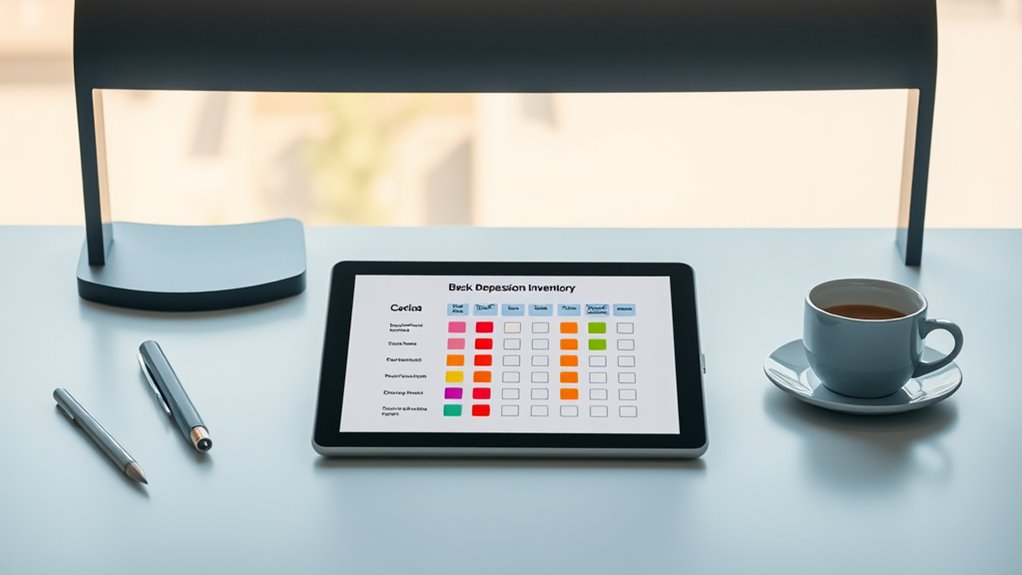The Beck Depression Inventory (BDI) is a self-report questionnaire designed to measure your depression severity quickly and effectively. It contains 21 items marked on a scale from 0 to 3, covering symptoms like mood, sleep, and social withdrawal. You can use it in clinical settings or for personal assessment, with various formats available. If you want to understand how this tool works and its strengths, exploring further will provide useful insights.
Key Takeaways
- The Beck Depression Inventory (BDI) is a self-report questionnaire measuring depression severity with 21 items.
- It was developed by Dr. Aaron T. Beck in 1961 and revised as BDI-II in 1996 to align with DSM-IV criteria.
- The BDI uses a 4-point scale for each item, with total scores indicating depression severity levels.
- It is available in various formats, including paper-based, digital, and short forms, suitable for clinical and research use.
- The BDI is validated for reliability and validity, making it a trusted self-assessment tool for depression screening and monitoring.
Overview and Purpose of the BDI

Have you ever wondered how mental health professionals assess depression quickly and accurately? The Beck Depression Inventory (BDI) is a self-report inventory that helps do just that. It consists of 21 items that measure the severity of depression by asking about common feelings and attitudes associated with depression. Understanding credit card terms is essential for financial literacy, just as understanding depression assessment tools is vital for mental health professionals. Designed by Dr. Aaron T. Beck in 1961, the BDI has been widely validated for its psychometric properties, including reliability and internal consistency. It takes about 10 minutes to complete and is suitable for individuals aged 13 to 80. The BDI’s primary purpose is to screen for depression and monitor treatment progress, providing a quick, standardized way to assess symptom severity in clinical and research settings.
Historical Development and Evolution of the Inventory

The Beck Depression Inventory (BDI) has undergone significant development since its inception in the 1960s, reflecting advances in understanding and diagnosing depression. Originally published in 1961 with 21 items focused on feelings and attitudes linked to depression, it was designed to quantify severity based on cognitive symptoms.
Over time, the inventory experienced several revision phases, including the development of the BDI-IA in 1978 and the BDI-II in 1996. These revisions aligned the inventory with updated diagnostic criteria, especially the DSM-IV, refining item wording and improving reliability and validity across diverse populations. Digital literacy has also contributed to the accessibility of the inventory through online assessment tools, broadening its reach. Additionally, ongoing research and clinical validation have helped to further refine its effectiveness as a diagnostic tool. The process of standardization has played a crucial role in ensuring consistent evaluation across different settings and populations. Furthermore, the integration of psychometric analysis has enhanced its precision and applicability in various clinical contexts. Moreover, the evolution of the BDI reflects a broader trend of incorporating technological advancements to improve mental health assessments.
The evolution of the Beck Depression Inventory highlights its ongoing adaptation to advances in clinical knowledge, ensuring it remains a relevant and effective tool for evaluating depression severity today.
Core Features and Format of the BDI

The BDI features 21 self-report items that measure depression symptoms and attitudes. It uses multiple-choice responses scored from 0 to 3. It’s quick to complete, taking about 10 minutes, and can be administered on paper, digitally, or in short screening forms. Understanding its structure, scoring, and formats helps you effectively interpret results across different settings. Additionally, familiarity with well-being assessment tools ensures accurate evaluation and monitoring of mental health status. Recognizing the impact of scoring methods on result interpretation is essential for reliable assessments. Being aware of assessment formats allows practitioners to select the most suitable method for diverse populations and clinical environments. Moreover, knowing the various scoring approaches can assist in tailoring interventions based on individual needs. Advances in AI-driven assessment techniques are also beginning to influence how mental health evaluations are conducted, offering new possibilities for accuracy and efficiency.
Item Content and Structure
What makes the BDI’s item content and structure effective for evaluating depression? It uses 21 carefully designed items that address a range of symptoms and attitudes associated with depression. These items are structured to capture the multifaceted nature of depression, ensuring a comprehensive assessment. Each item is rated on a 4-point scale from 0 to 3, indicating increasing severity. The questions cover key areas like mood, guilt, self-dislike, social withdrawal, sleep issues, and appetite changes, providing a thorough assessment. The scale is straightforward, with clear language that most people can understand easily, typically at a 5th to 6th grade reading level. This simplicity ensures accurate responses and quick completion. The format’s focus on relevant questions allows you to self-assess accurately, making it a reliable tool for gauging depression severity. Additionally, the effectiveness of the format is supported by its ability to facilitate honest self-reporting without confusion, which is essential in fostering emotional honesty and precise evaluation. Incorporating insights from psychometric research, the BDI’s structure enhances its reliability and validity in diverse populations. The clear and concise structure also helps minimize response bias, ensuring more accurate results across different groups. Furthermore, the design emphasizes standardization, allowing for consistent interpretation of results regardless of the respondent’s background.
Scoring and Interpretation
Scoring and interpretation of the BDI are straightforward, allowing you to quantify depression severity quickly. You simply add up the scores for all 21 items, with each rated from 0 to 3, to get a total score.
Key points include:
- Scoring: Sum responses to produce a total score indicating depression severity.
- Interpretation: Use cut-off scores to categorize depression as minimal (0–9), mild (10–18), moderate (19–29), or severe (30+).
- Depression severity: Higher scores reflect more intense symptoms.
- Cut-off scores: They guide clinical decisions, such as monitoring or intervention, ensuring consistency with standardized guidelines.
- Understanding scoring methods: Familiarity with assessment tools like the BDI helps clinicians interpret results accurately and tailor treatment plans effectively.
This method allows you to efficiently assess the level of depression and determine appropriate next steps.
Administration and Format
Have you ever wondered how the Beck Depression Inventory (BDI) is administered and formatted for effective use?
As a self-report questionnaire, it’s designed for individuals to complete quickly, usually within 10 minutes. The BDI is available in multiple formats, including paper-and-pencil, computerized versions, and short forms like the BDI-II and 13-item brief assessments. You’ll find each of the 21 items offers multiple-choice responses scored from 0 to 3, indicating increasing symptom severity. The questionnaire is straightforward and accessible, typically suitable for those with a 5th to 6th-grade reading level. After completion, scoring categorizes depression severity into minimal, mild, moderate, or severe, helping clinicians interpret your results accurately and plan appropriate treatment. Additionally, understanding the administration and format can enhance its effectiveness in clinical settings. Its transparency in scoring ensures that clinicians and patients can better understand the severity levels, facilitating targeted interventions. Being familiar with its format and scoring can also improve the reliability of assessments across different settings. Familiarity with the questionnaire’s structure helps in ensuring consistent administration and interpretation, especially given the importance of standardized methods in clinical evaluations.
Variations and Updated Versions

You’ll find that the BDI offers several format options, including shorter versions and digital formats, to meet different needs. The BDI-II was updated in 1996 to reflect current diagnostic standards and has remained reliable across populations. Additionally, various short forms and language adaptations help make the assessment more accessible and efficient. Self Watering Plant Pots are a practical example of innovative tools designed to improve plant care and reduce maintenance. Recognizing the importance of psychological assessment tools, the BDI continues to evolve to better serve clinicians and researchers. Utilizing Design Thinking principles can aid in developing more user-friendly and effective assessment formats that cater to diverse populations. Moreover, ongoing research into assessment reliability ensures that these tools maintain accuracy and validity over time.
Multiple Format Options
The Beck Depression Inventory (BDI) is available in various formats to suit different clinical and research needs. These options include:
- The short form, which offers a quick assessment in less than five minutes while maintaining validated reliability.
- Multiple formats, such as paper-and-pencil, computerized, and digital versions, for flexible administration.
- The original 21-item version and the updated BDI-II, both validated for diverse populations and settings.
- Different formats enable efficient, accurate screening and diagnosis, tailored to specific environments and time constraints.
Whether you prefer a brief, streamlined tool or a thorough assessment, these multiple format options ensure effective and validated administration suited to your needs.
BDI-II Development and Updates
Building on the variety of formats available for the original Beck Depression Inventory (BDI), the BDI-II was developed in 1996 to provide a more current assessment aligned with DSM-IV criteria. This updated version includes 21 self-report items rated on a 4-point scale, focusing on depression severity over the past two weeks.
Its psychometric properties are strong, with alpha coefficients around .86, guaranteeing reliable measurement across diverse populations. The revisions addressed cognitive, affective, and somatic symptoms, enhancing sensitivity to change and clinical relevance.
Short Form Variants
Have you considered how shorter versions of the Beck Depression Inventory (BDI) can streamline depression assessment? These short forms, like the 13-item version, offer a quick, dependable way to screen for depression without sacrificing accuracy. They maintain high internal consistency, with reliability coefficients around .81 to .86, comparable to the full version.
Variations include computerized, card, and paper formats, making them versatile for clinical, research, and digital settings. The BDI-II, with 21 items, provides a more exhaustive update aligned with DSM-IV criteria.
Here are some key points:
- The 13-item short form simplifies screening.
- High internal consistency ensures dependable results.
- Reliability remains strong across different formats.
- These variants facilitate efficient depression assessment in various environments.
Psychometric Strengths and Reliability

Psychometric strengths and reliability are key factors that make the Beck Depression Inventory (BDI) a trusted tool for evaluating depression. You can count on its strong psychometric properties, such as high internal consistency, with alpha coefficients ranging from .73 to .92 across diverse groups. The BDI-II has undergone extensive validation, showing excellent convergent validity with clinical diagnoses and other measures. Over 25 years of research confirm its reliability for both clinical and research use. The table below highlights its key features:
| Aspect | Details | Populations |
|---|---|---|
| Internal consistency | Alpha coefficients typically between .73 and .92 | Adolescents, geriatrics, physically ill |
| Validation | Strong convergent validity with diagnoses | Clinical and research settings |
| Short form | Maintains similar reliability, with .86 consistency | Versatile across various groups |
This robustness makes the BDI a dependable assessment tool.
Applications in Clinical and Research Settings

The Beck Depression Inventory (BDI) is a versatile tool that plays a vital role in both clinical and research settings. Here’s how it benefits you:
- Use the Beck Depression Inventory for clinical assessment to monitor depression severity over time, helping you track patient progress.
- Employ it in research applications to quantify depression symptoms, enabling precise statistical analysis and comparisons across populations.
- Benefit from its quick administration—around 10 minutes—making it ideal for large-scale screening and longitudinal studies.
- Rely on validated versions like the BDI-II, which have high internal consistency, ensuring reliable results across diverse samples.
Whether assessing individual depression levels or conducting research, the BDI offers a practical, evidence-based approach to understanding depression severity effectively.
Understanding Limitations and Appropriate Use

While the BDI offers valuable insights into depression severity, it’s important to recognize its limitations to guarantee accurate interpretation. As a self-report measure, its validity depends on honest responses, which can be affected by social desirability or lack of insight.
Physical illnesses or medications that mimic depression symptoms—like fatigue or weight changes—may inflate scores, reducing its specificity. Remember, the BDI is designed for screening and severity assessment, not diagnosis; clinical judgment and additional assessments are essential for accurate diagnosis.
Also, your mood at the time of completing the questionnaire can influence results, and factors like cognitive impairments or language barriers can hinder comprehension. Understanding these limitations helps ensure you use the BDI appropriately and interpret its results within the proper context.
Accessing and Utilizing the BDI

Wondering how to access and use the Beck Depression Inventory (BDI)? Here’s what you need to know:
Learn how to access and use the Beck Depression Inventory (BDI) with official resources and guidance.
- You can purchase official BDI kits, test forms, and support materials from Pearson Assessments or authorized providers.
- The manual provides detailed instructions for accessing the BDI and guarantees standardized administration.
- The BDI is available in formats like paper-based, computerized, and short forms such as BDI-II and 13-item versions.
- Utilizing the BDI in clinical or research settings is straightforward when you follow the manual’s guidelines, ensuring accurate scoring and interpretation.
Whether you’re a practitioner or researcher, accessing and utilizing the BDI becomes simple when you rely on the official manual and authorized resources.
Related Assessment Tools and Resources

Are you exploring assessment tools beyond the Beck Depression Inventory to evaluate depression or related conditions? Many assessment tools complement the BDI, each with strong psychometric properties validated through rigorous research.
For example, other self-report questionnaires and clinician-administered scales can provide a broader understanding of mental health. These tools often align with DSM criteria and are designed for reliable clinical evaluation.
The BDI itself has multiple versions, including the original 21-item, BDI–II, and a short form, all validated for consistency across diverse populations and languages.
Using a combination of these assessment tools helps guarantee accurate diagnosis and effective treatment planning. Incorporating these resources into your evaluation process enhances your ability to measure depression severity accurately.
Frequently Asked Questions
What Is the Beck Depression Inventory Assessment?
The current question asks about a depression assessment tool. You answer by explaining it’s a self-report questionnaire that measures how severe your depressive symptoms are.
You rate your feelings over the past week, usually on a scale from 0 to 3. This helps mental health professionals understand your condition better and plan appropriate treatment.
The tool is quick, reliable, and used worldwide to evaluate depression severity effectively.
What Is a Normal Beck Score?
Did you know that most people score below 10 on the Beck scale, indicating a normal mood? A normal Beck score is typically under 14, meaning you likely don’t experience significant depression symptoms.
If your score falls within this range, you’re generally considered to be in a healthy mood state. Keep in mind, scores below 10 are especially reassuring, suggesting minimal or no depression.
Is the Beck Depression Inventory Self-Report?
You’re asking if the Beck Depression Inventory is a self-report. Yes, it is.
You complete the questionnaire yourself, rating your feelings over the past week. This format allows you to directly express your symptoms like sadness, guilt, and fatigue without needing a clinician’s input.
It’s designed to be quick and accessible, giving you a personal way to assess your depression severity based on your own perceptions.
What Is a BDI Score of 37?
Your mental health is like a stormy sea, and a BDI score of 37 is a thunderclap signaling severe depression. It means you’re likely experiencing intense sadness, hopelessness, and possibly thoughts of self-harm.
This score shows your struggles are significant, affecting your daily life. Don’t wait for the storm to pass on its own—seek professional help now to find calmer waters and regain your footing.
Conclusion
Remember, the BDI is a valuable tool that offers insight into your mental health, but it’s only part of the bigger picture. Don’t rely solely on self-assessment—consult a professional for a complete understanding. As the saying goes, “A tool is only as good as how you use it.” Use the BDI wisely to guide your next steps toward well-being, knowing it’s just one piece of your mental health journey.









